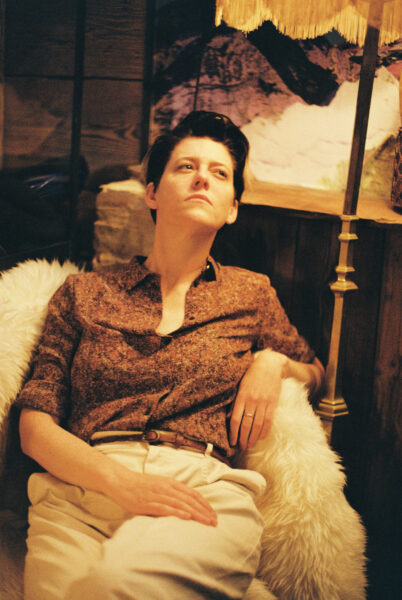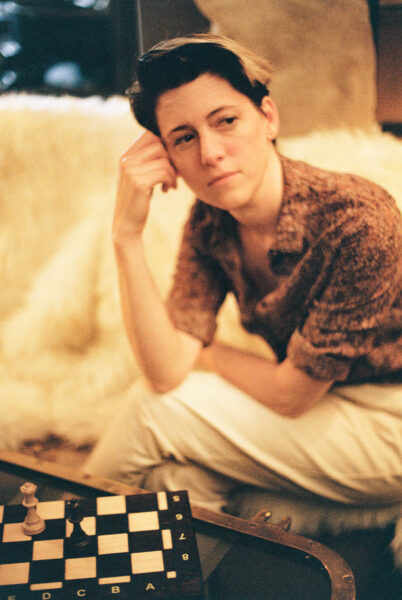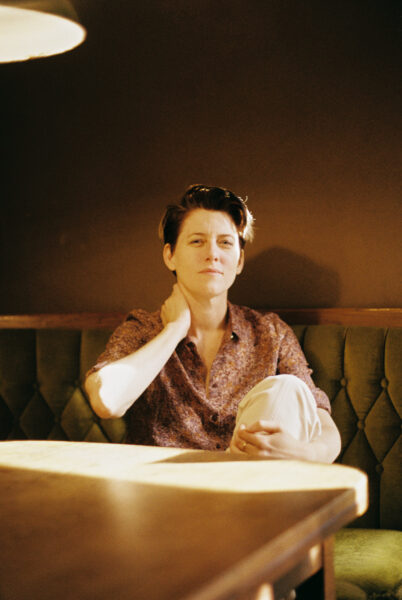For those who are familiar with Kat Frankie’s music know the warm coolness the singer’s raspy subdued vocals transport. Listening to her previous albums, I got a distinct idea of the artist I would meet. Someone who takes every word into consideration, who speaks and sings with care. Throughout her discography, the Australian singer shows that she pays attention to detail placing not a single unintentionally. I meet her in Berlin summer. A Friday afternoon at Holzmarkt – possibly not the best location for a quiet interview.
Kat moves the way she writes music: with the assured confidence of an artist who has found her language. She is wearing a floral blouse tucked into beige pants. We sit down at one of the bars on the premise right by the Berlin riverside. Grilled by the afternoon sun, the inside provides a refuge. But in trademark Berlin spirit, the venue is blasting electronic music on full volume. Our conversation is laced by the rhythmic techno in the background. Yet, our words find their way over the beat.
Music Like Carpentry
“In the process of producing this record, I learned something every day”, the singer and producer says. Shiny Things is what she calls, her best production work so far. There is a carpentry saying that Kat brings up – measure twice, cut once. She applied it in the process of making this record, making quality recordings in the first place rather than just getting them out and fixing them in the mix. This intentional way of working shows.
While, like all of us, Kat struggled during the pandemic, the artist also took the time to acquire some new skills. “It gave me the time to sit with the songs for longer.” Before that, most of the music was written while touring the previous album. “People got to focus on the production and writing part way more than before”, and reflecting on her own position in society, she adds “of course, this goes for people in privileged places”.
Rambling

During our conversation manifestation is a recurrent theme. “Isn’t that what art is all about?”, Kat grins. “There is this concept. It was not there before and then you bring it into the world. It is so exciting. Sometimes you have an idea and you don’t know if it’s good or bad until you manifest it.” Kat Frankie talks with the ease of someone who has navigated many interviews and social situations before. The laugh is easy on her lips and she jokes around saying that being an artist is the only job where people clap for you.
“The excitement on tour is different”, she says, comparing it to the writing process. “I connect with the audience. Producing and writing, I spend a lot of time on my own. We all get a bit funny. That is why the shared experience on stage is so magical. It brings people together and always creates something else.” Kat smiles as she reminisces about the effect that playing live has on her. “But I’m rambling. What do you need to know?” Kat Frankie is as straightforward as her music, in the most refreshing way.
The Shiny Things
Well, what is it that I need to know? What are the most intriguing aspects of Shiny Things? Perhaps a difficult question. Music and art are usually able to stand on their own and the interviews are a little extra, the cherry on top. Meeting the person behind the music, that alone provides a different insight into the creation. Looking at the latest releases of Kat Frankie, it is not just the music, but also the visuals that follow a certain direction. Shiny Things is inspired by a Baroque aesthetic. This makes for an interesting contrast to the music itself – the Baroque or Renaissance times were shaped by a white imperial male-centered subject, while Kat Frankie’s music has the political ambition to confront exactly those power structures.
Why then would a singer choose an aesthetic that is entangled with concepts and ideas she rejects? Does she manage to reclaim the aesthetic? “I wanted the record to follow one aesthetic thread. I like the light and dark – the Chiaroscuro of that era. That is how I write music. I always put loud and dark things next to light intimate things. I guess I just like the drama. It was an era of extremes,” she says. Extreme wealth and extreme poverty are captured in delicate Baroque oil paintings. Each brush stroke placed with intention; the mindset fits the way Kat Frankie records. Glory is portrayed with as much care as the miseries of humankind in a dialogue of differences on the canvas. It explains why a musician like Kat Frankie, who releases music that hits the political nail on the head, is attracted to imagery that captured both sides of the coin. While the portrayal of the darkness of humankind that we can see in some of the Baroque painters like Bosch might shock today, it is not as far removed from the present. If we took the time to paint today’s atrocities in oil again, would we inspire more sustainable change and empathy that 24-hour long-lasting Instagram stories?
What Can Art Do?
Admittedly, those are places that my thoughts wander off to when listening to Kat Frankie talk about the Renaissance aesthetic. “For me, it was also a resonance on the visual, superficial level. I have always lived in that aesthetic a little and will continue to do so.” The detailed brush strokes can also be found in the music of Shiny Things. Don’t let yourself get distracted by the title; Kat Frankie gets down into the dirt. Borrowed from Taoism, the song Be Like Water takes you right into the protests in Hong Kong, interlacing music with chants of protesters. To not deal with the topic superficially, the artist did a lot of research on protests, protest art, and the role of art in revolution. Her music has been called melancholy protest music.
“It is interesting. Art and class are so intertwined. The art world is dominated by Western children of the rich that become artists and then participate in political art in a performative way rather than having their skin in the game.”
While the deep house beats of the café are still pumping around us, Kat Frankie also reflects her role in protest music. “I can write a song about the democracy in Hong Kong. But what does that mean? I am safe, I am writing this music from a safe place. I thought a lot about the role of the art and the artist in the political context – also over the pandemic when everybody was out for the BLM protests. What can art do in those moments? I don’t know, that is also why I made a Zine with contributions by many artists and professors on that topic.”


The Role of Artists
It takes guts to admit that you don’t know the answers. Especially in political discussions it seems like people always expect you to have a distinct answer and an opinion on everything, often forgetting the situated-ness of the people talking. Who am I to discuss the democracy in Hong Kong? How can I talk about things sustainably and inspire change?
“I am completely overwhelmed”, Kat laughs when I ask her how she deals with the feeling of getting paralyzed by the many injustices, violence, and wars brought to light and lived by people every day. “The record is political, but I am definitely overwhelmed by it. You just have to write about what’s on your mind to process. Sometimes just the process of describing it helps. Most of my songwriting is just describing a thing that is itching. I am lucky that I have this thing I can do. I would go crazy otherwise.”
Through the Cracks
Be Like Water also takes inspiration from literature by Ursula Le Guin. In the dystopian world of the afro-futurist writer the singer found inspiration for new strategies to navigate political unrest. “Be like Water. That comes from the idea that the protesters should keep moving, appear and disappear, not gather in one place, the decentralized structure of the movement kept the Chinese government from arresting a leader at the top. Water is flexible. It is so soft, but it has the power to wear down stone. I guess that resonated with me because it describes the persistence of protest movements.”
The water seeps into the cracks. Nothing is safe from water spreading, it eventually leaks into the most ancient of stones. It is also a great metaphor for a horizontal distribution of power as its power lies in its collectivity. One drop of water cannot inspire change, but to a whole flood even the most powerful structures will bend.
Melancholy and Prostest
So when people describe Kat Frankie’s music as melancholy protest music – I get the protest part of the equation. But melancholy, is melancholy not antithetical to the nature of protest itself? Melancholy as the lingering in an emotion or aching for a moment that has never been? Or is it in that way, maybe essential and inspires protest? “I think melancholy and protest go together”, Kat agrees.
“Protest music is traditionally arousing. It gets people to sing along or motivates to move. But there is a space for a kind of protest music that is part of a dialogue, that opens up spaces and raises questions. I don’t have the answers and I cannot tell people what to do. I am questioning and describing putting things on display and into conversation.”
This is a different kind of protest, a quiet revolution that Kat is participating in to highlight the things that might go unnoticed by the mainstream discourse situated in Berlin. If melancholy is a state of dwelling it seems antagonistic to the activating nature that protest music aspires to have. “Does protest not always need to come from a certain melancholia?” Kat wonders. “What is collective action – a collection of people who thought about the kind of world they want to live in, and they want to change the way it is right now by taking action. But in order to realize that you need a moment where you connect with yourself – perhaps a moment of melancholy.” If melancholia also extends to a state of yearning, it might be necessary to inspire the needed vision or hope for change that protest requires. We need to be able to imagine a different future in order to change the present.
Radical Hope
 The relationship between utopia and dystopia are concepts that circulate a lot in art but also in social sciences like gender studies. This back and forth between dark and light echoes in the song is echoed in the songwriting of Kwriting of t Frankie. Using contrasts to create an odd equilibrium between the two, the album is equally a document of the gloom and despair as it is an act of resistance and with that – an act of hope. “Everyone has their own vision of utopia. Is it utopia when there is equality and justice? Maybe,is echoed in the songwriting of a but another person’s utopia might not look like this. It cannot be defined.” As Kat speaks, my thoughts to go the texts I have read on the performative power of utopian thinking – in queer theory and in decolonial studies. The privilege of being able to conceive of a utopia and its necessity to inspire change. Utopian thinking seems to be a prerequisite for change, I say and the singer counters “but maybe that is just optimism”. With a laughter, she simplifies my overly complex and academic approach to the concept. And yes, makes me wonder whether there are differences between this sort of utopian thinking and sheer optimism.
The relationship between utopia and dystopia are concepts that circulate a lot in art but also in social sciences like gender studies. This back and forth between dark and light echoes in the song is echoed in the songwriting of Kwriting of t Frankie. Using contrasts to create an odd equilibrium between the two, the album is equally a document of the gloom and despair as it is an act of resistance and with that – an act of hope. “Everyone has their own vision of utopia. Is it utopia when there is equality and justice? Maybe,is echoed in the songwriting of a but another person’s utopia might not look like this. It cannot be defined.” As Kat speaks, my thoughts to go the texts I have read on the performative power of utopian thinking – in queer theory and in decolonial studies. The privilege of being able to conceive of a utopia and its necessity to inspire change. Utopian thinking seems to be a prerequisite for change, I say and the singer counters “but maybe that is just optimism”. With a laughter, she simplifies my overly complex and academic approach to the concept. And yes, makes me wonder whether there are differences between this sort of utopian thinking and sheer optimism.
Dystopian thinking might also be a coping mechanism to not get disappointed. If you believe in utopia, you have hope, and vice versa. Radical hope could maybe also be criticized as useless, but it can be productive to be delusional sometimes. “Do you need to be delusional to make music?” I ask Kat and she replies with pure sincerity “oh god, yes”. Shiny Things is as much a document of that necessary creative delusion as it is the work of an artist who engages with political and societal themes on the deeper level. Meeting Kat Frankie confirms my image of a reflected singer who remains open and eager to learn, to pose questions, and to grow – always with a note of hope in her voice. Because if to cope with these times, hope is what we need.
Photos by Liv Toerkell.
Shiny Things is out now via Groenland Records.
